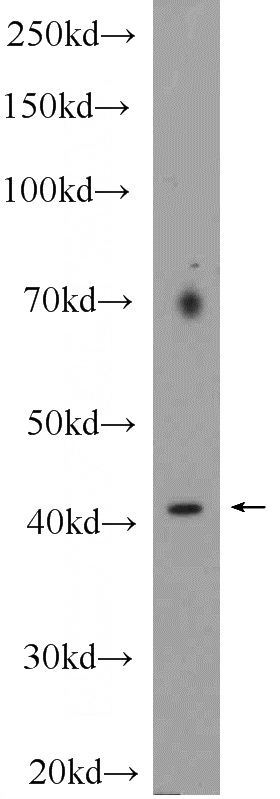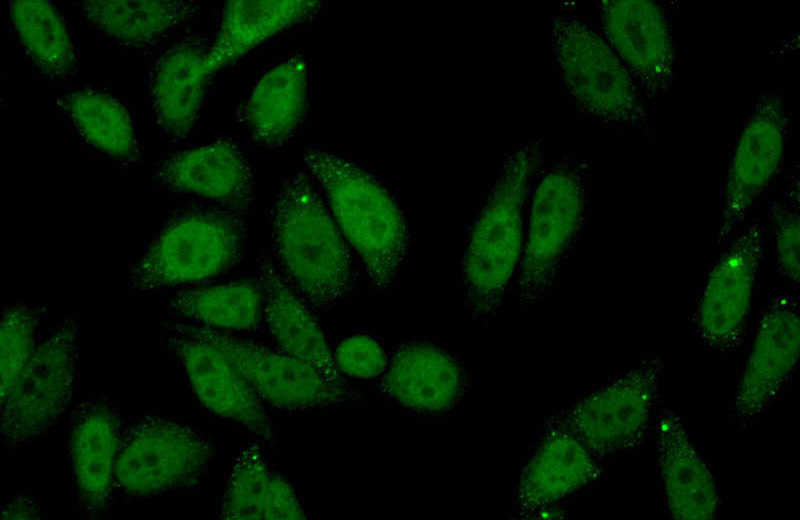-
Product Name
SPOP antibody
- Documents
-
Description
SPOP Rabbit Polyclonal antibody. Positive IP detected in HeLa cells. Positive WB detected in HeLa cells, HepG2 cells, MCF-7 cells. Positive IF detected in HepG2 cells. Observed molecular weight by Western-blot: 42 kDa
-
Tested applications
ELISA, WB, IP, IF
-
Species reactivity
Human,Mouse,Rat; other species not tested.
-
Alternative names
HIB homolog 1 antibody; Roadkill homolog 1 antibody; speckle type POZ protein antibody; SPOP antibody; TEF2 antibody
-
Isotype
Rabbit IgG
-
Preparation
This antibody was obtained by immunization of SPOP recombinant protein (Accession Number: XM_005257724). Purification method: Antigen affinity purified.
-
Clonality
Polyclonal
-
Formulation
PBS with 0.1% sodium azide and 50% glycerol pH 7.3.
-
Storage instructions
Store at -20℃. DO NOT ALIQUOT
-
Applications
Recommended Dilution:
WB: 1:200-1:2000
IP: 1:200-1:1000
IF: 1:50-1:500
-
Validations

HeLa cells were subjected to SDS PAGE followed by western blot with Catalog No:115581(SPOP Antibody) at dilution of 1:600

IP Result of anti-SPOP (IP:Catalog No:115581, 3ug; Detection:Catalog No:115581 1:300) with HeLa cells lysate 3200ug.

Immunofluorescent analysis of (10% Formaldehyde) fixed HepG2 cells using Catalog No:115581(SPOP Antibody) at dilution of 1:50 and Alexa Fluor 488-congugated AffiniPure Goat Anti-Rabbit IgG(H+L)
-
Background
The SPOP (TEF2) protein was previously identified as an autoantigen in a patient with scleroderma pigmentosum. SPOP (speckle-type POZ protein), also known as TEF2, HIB homolog 1 or Roadkill homolog 1, is a member of the Tdpoz family containing one N-terminal MATH (Meprin and TRAF Homology) domain and one C-terminal BTB/POZ domain. SPOP can exist as a homodimer and is expressed in a variety of tissues localizing to the nucleus. Through an interaction with CUL-3, SPOP is involved in ubiquitinylation and protein degradation. SPOP specifically interacts with CUL-3 via its BTB/POZ domain and recruits substrates to the CUL-3-based ubiquitin ligase via its MATH domain. Substrates recruited by SPOP and targeted for ubiquitylation via the CUL-3/SPOP complex include PDX-1, Bmi-1, MacroH2A, PIPK II ∫ and Daxx. These substrates are subsequently degraded by the proteasome. In addition, SPOP itself becomes ubiquitylated by the CUL-3-based ubiquitin ligase and is targeted for proteasomal degradation.
-
References
- Gao K, Jin X, Tang Y. Tumor suppressor SPOP mediates the proteasomal degradation of progesterone receptors (PRs) in breast cancer cells. American journal of cancer research. 5(10):3210-20. 2015.
Related Products / Services
Please note: All products are "FOR RESEARCH USE ONLY AND ARE NOT INTENDED FOR DIAGNOSTIC OR THERAPEUTIC USE"
